Rockfishing is one of the most popular types of sea fishing with spinning rods. The process of catching “ambush” predators is very exciting and makes the angler show skills and ingenuity to figure out the place where the predator hides without losing the lure among the rocks.
Rockfishing, like many other types of fishing, originated and developed in Japan and was spread all over the world. Instead of getting into the thick of “rockfishing” fights in the Land of the Rising Sun, adriaticnature decided to talk on this topic with a wonderful fisherman from Vladivostok, a hardcore fan of rockfishing, Mikhail Starovoytov, who spends most of his free time on the sea with a spinning rod in his hands.
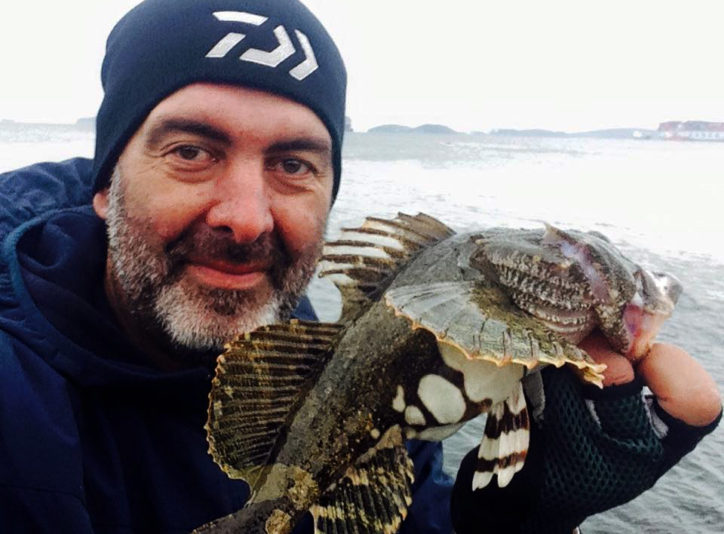
(Mikhail Starovoytov with the caught sculpin. Photo © Mikhail Starovoytov)
– Mikhail, let’s try to figure out the terminology at first. Rockfishing, sea UL. Do these terms mean the same thing? Or are fishermen considered to go in for rockfishing only as soon as they step on a rock? And if they don’t do it, they go in for anything but rockfishing. Right? Or, maybe, rockfishing means catching fish species, which are referred to as “rockfishes” in English, doesn’t it? Most often small representatives of the Scorpaeniformes order hiding among the rocks at the bottom are called rockfishes. But if fishermen catch fish of the Gobiformes order, they are not “rockfishers”. They are considered to just go in for sea ultralight.
Oh, so many spears have already been broken by fishermen while discussing this topic. The term “rockfishing” can be interpreted in different ways: it can be fishing from rocks, but, at the same time, it can be catching “rockfishes” (fish that live among the rocks). Ultralight is just the weight category of tackle and lures, which you catch fish with. By the way, you catch not only “rockfishes”, but all fishes that swim in the sea. Rockfishing is a combination of fishing targets, purpose-designed tackle and technique.

(Rockfishing in action. Photo © Mikhail Starovoytov)
– Does rockfishing imply the use of light lures, or can catching groupers with rather heavy lures be considered rockfishing?
Rockfishing implies the use of light lures for sure, but there is also such a section as HRF – “hard”-rockfishing, which involves catching groupers with large rubber, for example.
– Let’s discuss the compulsory components of rockfishing. The target of fishing is predatory and not very predatory fish, inhabiting a rocky bottom and hiding in ambushes. Does rockfishing really require special rods? If so, what characteristics should they have?
Almost any fishing “specialization” implies the availability of special equipment to achieve maximum results and pleasure from the process. Rockfishing rods are usually elegant, but, at the same time, there must be a powerful butt that enables you to face the bites of quite serious fish, which happen quite often on the sea. Rings are adapted for the thinnest cords or monophilic fishing lines, they are put rather frequently and “pressed” very close to the blank in order to minimize “spurious” oscillations of the cord when casting the lure, reducing its distance.
“Rockfishing” rods are classified into “solids” and “tubulars”, according to the tip type. “Solid” is a monolithic insert, “tubular” is a hollow insert. “Solid” is more sensitive, their specialization is light jig heads and soft plastic lures, although they work well with small jigs/metal jigs and light plastic lures as well. “Tubulars” are really versatile, they cope with the whole range of rockfishing lures perfectly.

(Walleye pollock caught from the rocks. Photo © Mikhail Starovoytov)
– Probably, a lot of anglers, who plan to go fishing from the sea shores on the same vacation, primarily think about light rockfishing, since the chances of enjoying the process and achieving good results are still higher with LRF. You fish a lot from the rocks in the vicinity of Vladivostok, often travel and, probably, have the tackle you always take on a fishing trip, don’t you?
I have several rockfishing sets. There is ultralight, and there is light as well. Currently, I consider the best set for UL to be a fishing rod with dough weighing 0.4-5 grams and a reel of 2000 size (according to the classification of Shimano), with a small spool and a high ratio. By the way, all my reels have high ratio. As for “light” – a fishing rod with dough weighing up to 12 grams and a reel of 2506 size (according to the classification of Daiwa). Currently, my UL set is the Palms Pinwheel PTMSS-76 fishing rod with the Abu Garcia ALX 2000SH reel. Light – Yamaga Blanks 76 Stream with the 12 Luvias 2506H reel. I often use my favorite “squid” rod Abu Garcia Salty Stage Egisys with lures weighing up to 30 g.
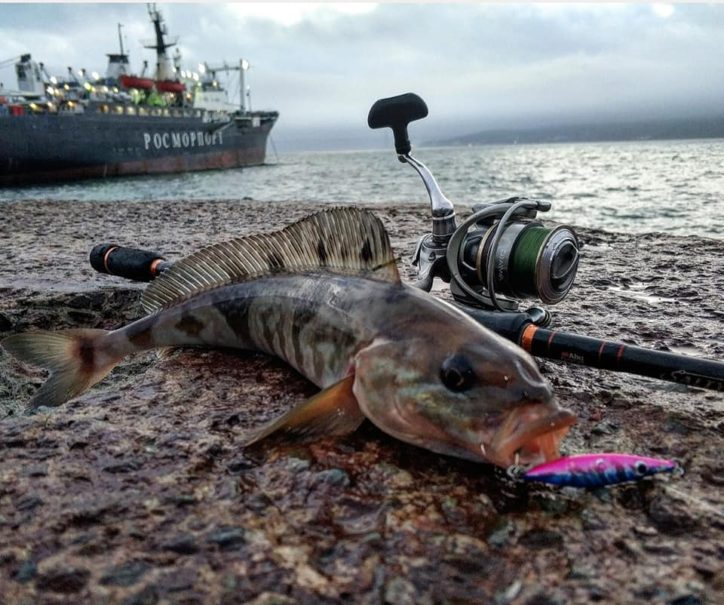
(Greenling caught with the 14-gram Crazy Angler jig. Photo © Mikhail Starovoytov)
– I want to ask you about rods designed for catching squids. Why do they end up in the hands of anglers who use them successfully, but often for other purposes?
Egi – “Squid” rods are light, very sensitive, have an amazing casting efficiency and powerful. They are designed to animate large Egi lures – special lures for catching squids, which means they can easily cope with firm plugs and jig rigs. As for me, I adore fishing with Egi-rods and use them most often when fishing with metal jigs/jigs.
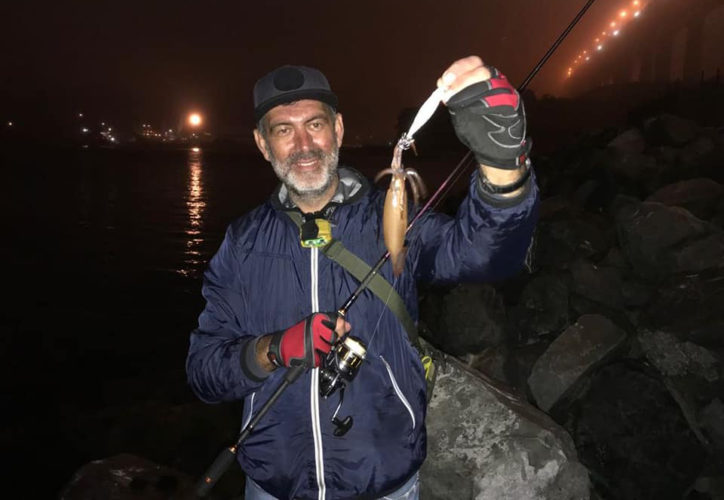
(Egi (squid) rod, used as intended. Photo © Mikhail Starovoytov)
– Since we are talking about lures, what types of lures do you use in rockfishing most often? Which lures do you usually start fishing in an unfamiliar place with?
If I plan “mebaring”, that is, catching small rockfishes (mebaru in Japanese), of the Scorpaeniformes order on rocky slopes, I would most likely start with miniature soft plastic lures on light jig heads. Or with a small jig/metal jig.
If I’m going to fish in a shallow creek or bay, with a sandy-pebble bottom, then I would most likely choose a buler with the Marukyu worm or a barakuri with the Sand Worm worm produced by Berkley. In my experience, the “edible” silicone by these two producers is the best means of fish detection.
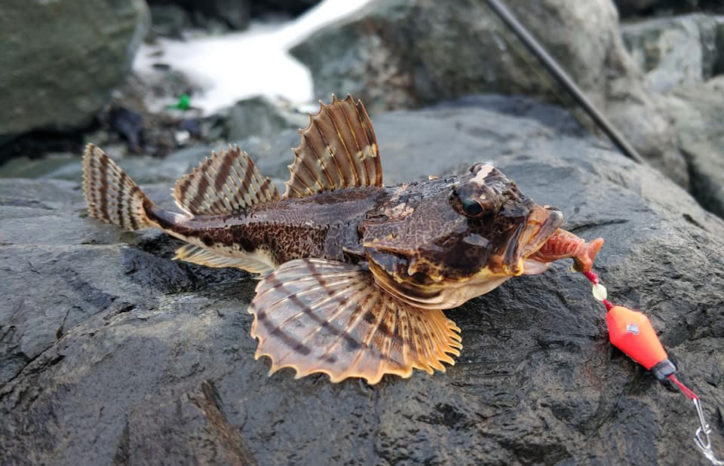
(Scuplin, caught with a barakuri with the “edible” Marukyu Isome worm. Photo © Mikhail Starovoytov)
– Let’s talk a little bit about bulers and barakuri. It turns out that these two types of lures are well known to Japanese and Far Eastern fishermen, but almost no one knows about them in Europe. Tell us please what these lures are, what are the fundamental differences between them, what weights do you use more often and what is their preferred animation?
Bulers and barakuri are a brilliant invention of the Japanese, and I don’t exaggerate at all. A buler is a slightly bent lead alloy plate. A single hook hangs on a piece of cord on one side of this plate; a swivel is fixed on the other side of the plate for mounting on a fishing line. One can catch fish with the buler using various techniques: you can “tap” the bottom in the classic jig style, in search of flounders and other near-bottom inhabitants, or you can catch fish in the pelagic zone, i.e. in the water column, retrieving the lure the way you want.
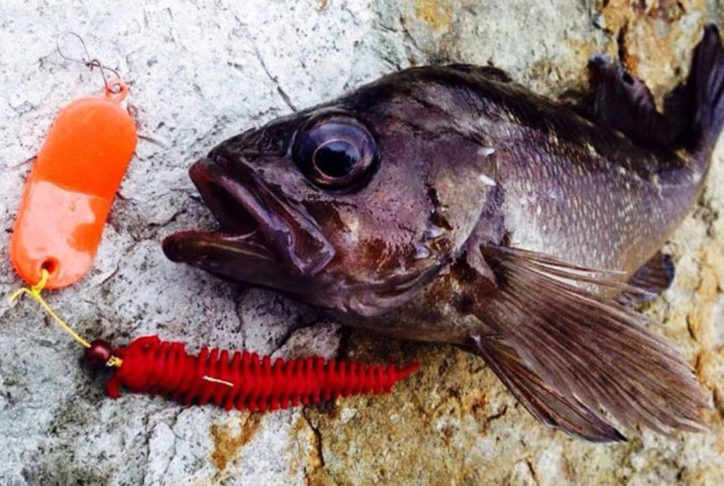
(Sebastes taczanowskii, caught with a buler with the “edible” Sand Worm worm produced by Berkley. Photo © Mikhail Starovoytov)
A barakuri is a pronounced bottom lure, which comes in a lot of different shapes – rhombuses, balls, flats, pyramids and so on. It is my main lure for flounder fishing. You can catch fish with it both by casting and vertically, from a boat. The efficiency of the buler is such that the “newly-converted” rockfishers often forget about the variety of assemblings, focusing only on it: “Fish bite it. What else do you need?”.
Bulers are usually painted with bright colors, often light-accumulating. Barakuri are more often red. The range of weights is wide, starting with three grams and more.
One of my favorite flounder lures is the Sasame barakuri with Sand Worm worms produced by Berkley. The assembling is proven and trouble-free. I fish with them from the shore in relatively shallow bays with a sand and pebble bottom, where you can safely tap the bottom.
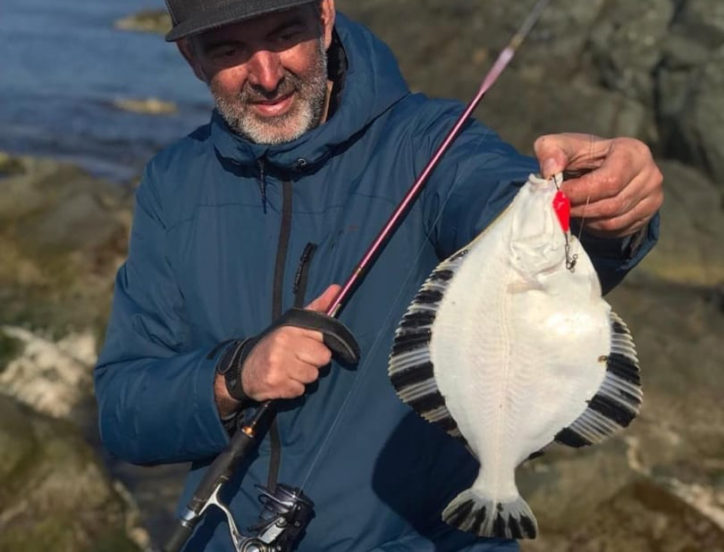
(Starry flounder, caught with the Sasame barakuri with the “edible” Sand Worm worm produced by Berkley. Photo © Mikhail Starovoytov)
As for the bulers, I should mention that in this part of the world I use them mainly for catching Tribolodon sachalinensis and a little less often for catching flounders. As I’ve already mentioned, bulers, due to their shape, are really suitable for fishing in the shallows, over thickets of algae – where our Tribolodon sachalinensis like to “graze”. It is a very lively fish! The bites are sharp, powerful, sometimes you don’t even need hooking. When playing, it keeps fighting until the very last minute. This fish one of my favorite rivals.
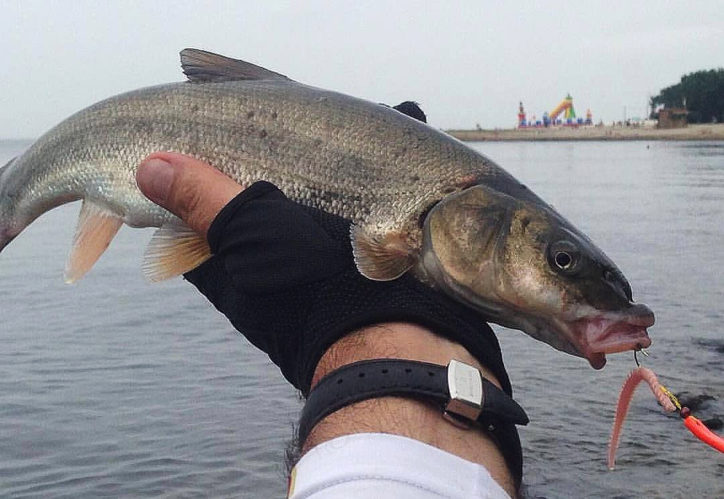
(Tribolodon sachalinensis, caught with a buler with the “edible” Marukyu Isome worm. Photo © Mikhail Starovoytov)
When catching Tribolodon sachalinensis, the retrieve is as follows: cast, heave in the slack, let the buler go deeper, and start a smooth retrieve, with pauses, accelerations and slight movements of the lure with the tip of the spinning rod. Often, there is a bite during falling, you don’t even have time to close the bail arm, literally from the surface. The Tribolodon sachalinensis sucks in the food, so the buler, with its hook hanging on the assist-line, fits perfectly. Alternatively, you can use light spoons, weighing 1.5-2 grams. It’s a proven option as well.
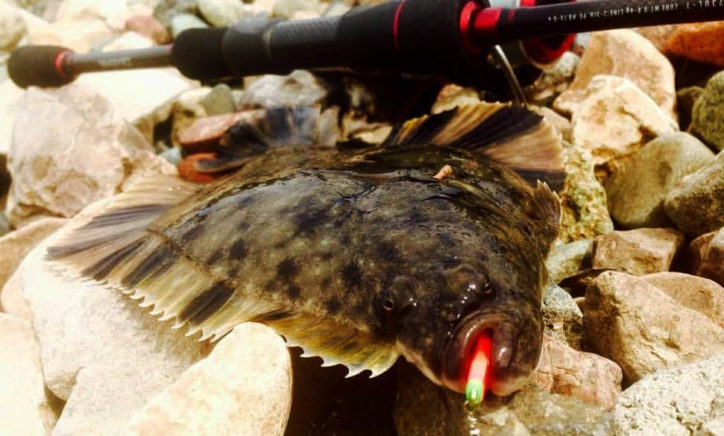
(Starry flounder, caught with the Fujiwara buler with the “edible” Marukyu Isome worm. Photo © Mikhail Starovoytov)
– Let’s talk about jig heads. Fishing at a rocky bottom is a slippery slope for the lure, it strives to remain hooked on an obstacle in its way. How can anglers secure themselves from hooks during rockfishing? Should the lightest possible weights be used? Should jig heads of certain shapes be used? Anything else?
First of all, you should explore the place of fishing – the bottom topography, whether there is a current, etc. But in any case, using the freshwater jig technique with a classic step at the sea rocky bottom is a deliberately wrong decision. The vast majority of heads for rockfishing are thrust ones, designed for fishing in the water column, at the bottom, but without touching the bottom. That’s how we catch fish, retrieving the head “on slippery ground”. At first, hooks can’t be avoided, you need to be prepared for this, but when you get enough experience, everything will be OK and the number of cases of getting off the hook will be minimal. Usually, the heads, which I use in ultralight, weigh from 1 to 3 grams, and as for bottom assembling – up to 5 grams.

(Sculpin, caught using the Brilliant Head jig head. Photo © Mikhail Starovoytov)
The Brilliant Head jig heads by the Japanese company 34ThirtyFour, weighing 2 grams, have been the permanent inhabitants of my box for the last three years. They are perfectly combined with the stretch rubber, for example, with Daiwa Gekkabijin Crossbeam or Swordbeam.
My favorite classic thrust jig head is Upper Cut by Japanese producer Magbite. I actively catch “mebaru”, mackerel, Tribolodon sachalinensis, and other fish species in various seas.
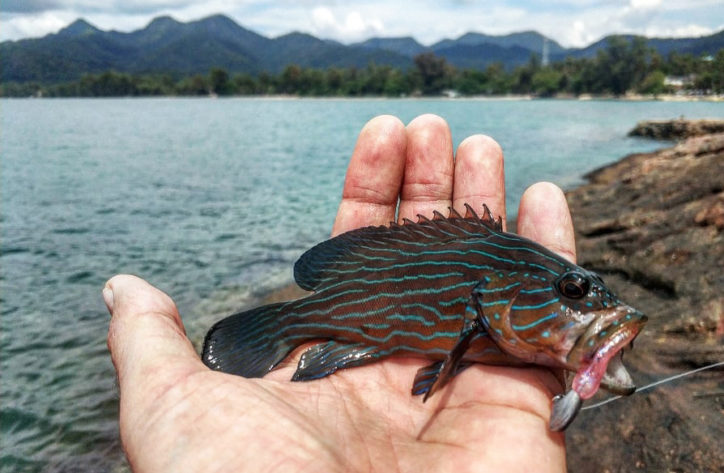
(Small grouper, caught using the Upper Cut jig head. Photo © Mikhail Starovoytov)
– The same goes for jigs – the slightest unfortunate touching the bottom by assist-hooks – and say goodbye to the jig. Do you use retrieving over the bottom? Do you reduce the number of assist-hooks? Do you use special hooks?
Jigs are only for the pelagic zones, and not for the bottom. The number of assist-hooks depends on the weight of the metal jig. I usually put one on the head of light jigs, and two or three assist-hooks on heavy ones. I knit assist-hooks by myself, it’s not a problem to buy fittings and good hooks nowadays.

(Greenling, caught with the Temp Jig jig produced by UST. Photo © Mikhail Starovoytov)
The Tempt Jig jig, produced by the Korean company UST, is one of my favorite casting metal jigs. It’s a versatile lure. I fish with it both from the shore and from the kayak. It falls perfectly in the water column and perfectly “holds” the horizon.
13iSlider produced by the Japanese company Breaden has been my favorite one for several last years. Its unusual gliding can’t leave indifferent almost any sea inhabitant, even squid. There were many times when I selected and tried all the lures out of the box. Then, I put the iSlider and felt the long-awaited bite from the first casting. It’s a very efficient jig/metal jig.
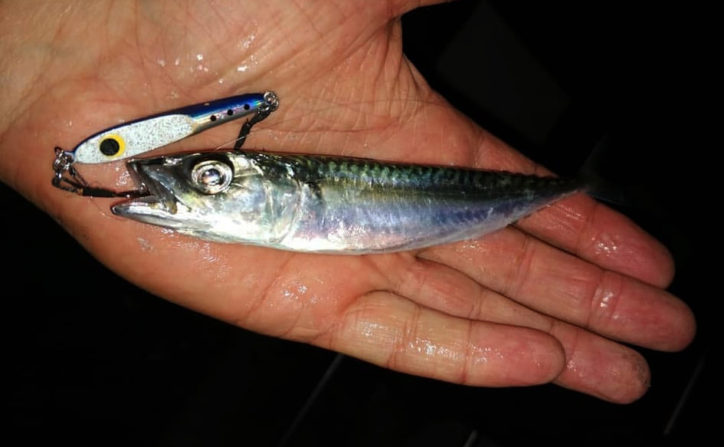
(Mackerel, caught with the 13iSlider jig produced by Breaden. Photo © Mikhail Starovoytov)
– How often do you use other lures in rockfishing? Vibs, sticks and others? In what cases?
I use vibs, sticks, small plugs on almost every fishing trip with ultralight/light. And it happens so that quite often I fish only with them, forgetting about soft plastic lures and “iron”. After all, catching fish with them is both fun and extremely interesting!
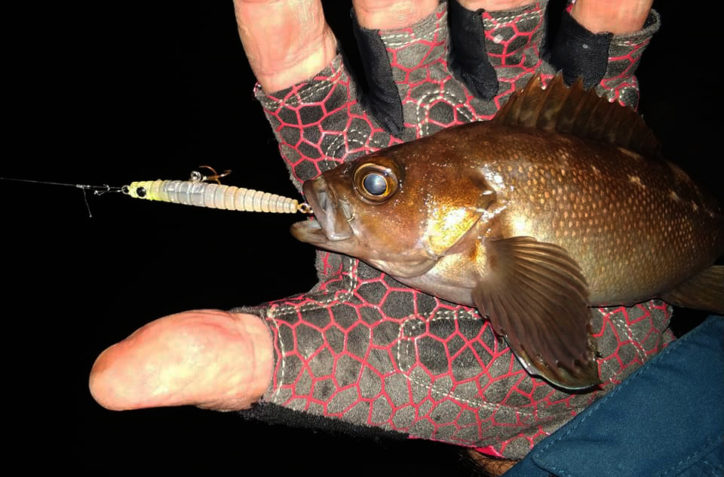
(Sebastes minor, caught with a silicone stick produced by Madness. Photo © Mikhail Starovoytov)
A two-gram silicone sinking stick produced by the Japanese company Madness is one of my favorite lures. Rockfishes are mad about it!
Another lure that is always in the box is a micro vib. My favorite one weighs five grams and is produced by the Korean company K-Good. It flies far, generates powerful vibrations during smooth retrieving, actively “collects” fish. You can add a vertical component to the retrieve by pausing. It is better to replace triples with singles. Many producers have similar things, but Koreans make very good lures, and as for the price, they definitely win over Japanese companies.
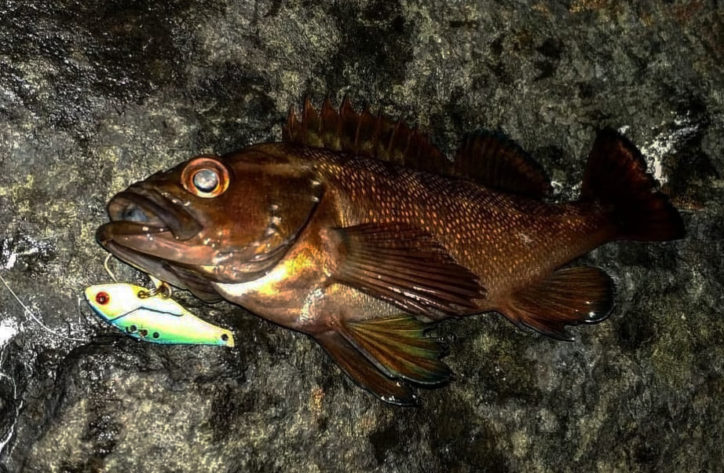
(Sebastes minor, caught with a vib produced by K-Good. Photo © Mikhail Starovoytov)
– Please tell us more about fishing for flounders from the shore. We would like to implement your experience for the Mediterranean coast, abundant in various representatives of flatfishes. What is the best way to catch them?
Flounder is a quite unpredictable fish, still full of mysteries, at least for me. It should come as no surprise that you should look for it on a slightly sloping bottom with a soft cover, in which the flounder digs itself and makes an ambush. In our waters, flounders can be found both really close to the shore, at the distance of casting the lightest lure, and at a sufficient distance, when you have to try really hard to cast.
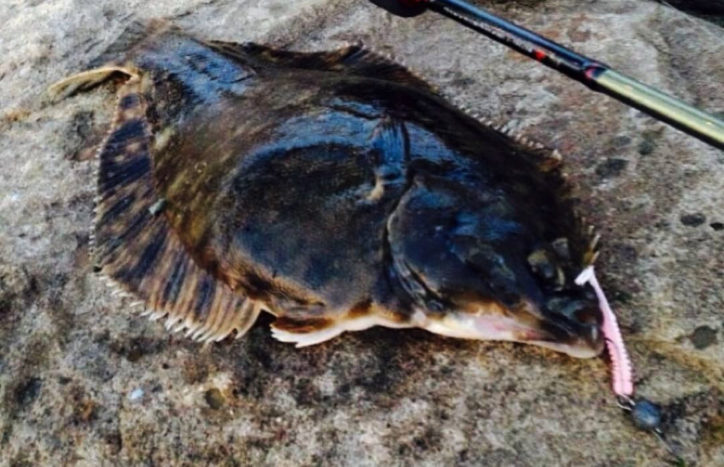
(Starry flounder, caught with a two-gram lure. Photo © Mikhail Starovoytov)
When I fish with barakuri and bulers, I choose the following tactics: I put the lure at the bottom and start playing with it, lifting and dragging it, muddying the water. Retrieving is unhurried, without sudden movements. If I fish with “iron”, then I retrieve the lure at the bottom, sometimes touching it, with the same slow drags. When fishing for flounder, I always equip the assists with lurex – Miss Flatty likes shiny stuff.
Despite the pronounced bottom type of habitat, flounders often swim up several meters from their bed, if an interesting target for chasing appears, bites often occur in the “half-water”. A friend of mine caught flounders with small sinking plugs.

(Starry flounder, caught with a 25-gram jig equipped with a single assist-hook with lurex. Photo © Mikhail Starovoytov)
So there is a wide choice of flounder fishing lures, but I would advise starting the “exploration” of these interesting fish from bottom assembling with edible rubber, even the simplest ones, it doesn’t have to be barakuri and bulers. Chances of catching the fish will be the highest with them. The last time a friend of mine, the famous Russian fisherman Andrei Starkov, went on a fishing trip to Kamchatka, the “edible” crabs produced by Marukyu, fitted on bulers and barakuri, proved to work excellently. You should experiment, and you’ll achieve great results for sure.
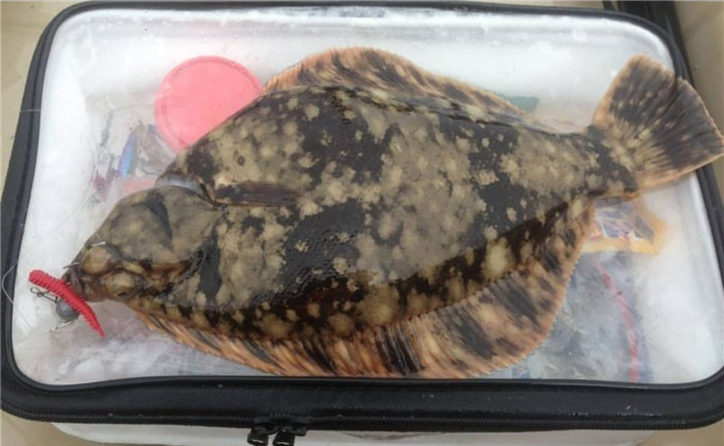
(Cresthead flounder, caught with a 10-gram swivel assembling with the “bloody” Sand Worm 2. Photo © Mikhail Starovoytov)
– The word “mebaru” is familiar to many anglers who are interested in sea fishing. This is due to the fact that many producers recommend using their certain lures for catching “mebaru”, and sometimes they even name their tackle in honor of this fish. What kind of beast is this? And why does it attract the Far Eastern fishermen so much?
I must say right away – there is no classic “mebaru” in our waters. I mean the one that we can see in many videos of Japanese rockfishers. The Japanese call it “bamboo”. But, we have its relatives – Sebastes taczanowskii, it is called “ezo-mebaru” in Japanese, and Sebastes minor. Thanks to me, these perches are called “mebariki” in our country, affectionate diminutive of “mebaru”.

(Sebastes minor, caught with jigs. Photo © Mikhail Starovoytov)
What kind of “beast” is this? It is a relatively small fish (the maximum size of a Sebastes minor is 20 cm, the Sebastes taczanowskii – one may be 30 cm long), living in large schools, the so-called “families”, settled down without making distant migrations. Sometimes, it swims much deeper to spend winter, but it returns to the “habitable” places in spring.
In this part of the world, these fish live everywhere. Perhaps this is one of the reasons why these fish are very popular with our rockfishers, as well as the rest of the anglers. Another factor of popularity is the relative simplicity of catching these perches. By and large, you can catch them with any fishing rod, with any jig head, suitable in weight, and with any, the most trivial “no-name” silicone. Indeed, many anglers do it. Some fishermen catch them using float fishing, which can be quite efficient. But you get the true pleasure, if you use purpose-designed, delicate and sensitive tackle. To be honest, considering the diversity of the ichthyofauna of our waters, I spend most of my time “mebaring”.

(Sebastes minor, caught with a jig. Photo © Mikhail Starovoytov)
It’s noteworthy that the list is not limited to these two representatives of Sebastes (the Latin name for the genus of rockfishes of the Scorpaenidae family). Sebastes trivittatus and Korean rockfish (Sebastes schlegelii) – the “king” of perches, strong gray-and-black bombshell – prey on the same slopes.
Small rockfishes are like chavs. As soon as they see something at least resembling prey, they rush and attack it with hooting and whistling. Their big brothers are solitary, sedate, leisurely and damn powerful!
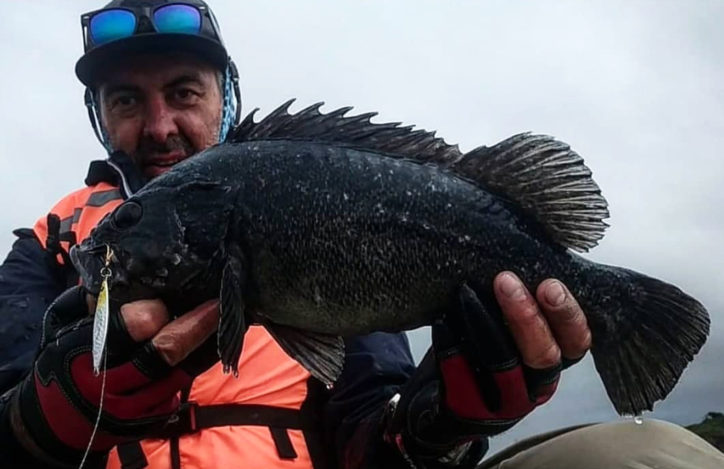
(Korean rockfish, caught with a jig. Photo © Mikhail Starovoytov)
– Tell us please about the peculiarities of fishing in Vladivostok and its vicinity. Due to the fact you’re your city is situated far from the European part of the continent, it is rather difficult for a fisherman who hasn’t visited your region to imagine rockfishing and other kinds of sea fishing in the Russian Far East. Should a fisherman going on a business trip or on vacation take rockfishing tackle?
Be sure to take a spinning rod! And the best choice is light, weighing up to 10 grams – this will cover a wide range of our fish. In my opinion, UL and light provide maximum opportunities on the sea, because in these two categories of fishing with a spinning rod the same lures are used as in the “big game”, but they are just scaled down. Sticks, vibs, plugs, various jig heads, bulers, barakuri. The list is endless.
Rockfisher’s fishing season starts early enough. In April, walleye pollock approaches the shores for spawning. The fish is large, schooling, responds well to most well-known jig rigs. Starting with May, almost all the inhabitants of the coastal zone become active and a real fishing life begins.

(Walleye pollock, caught with a jig. Photo © Mikhail Starovoytov)
Vladivostok is surrounded by the sea on three sides: on the east side – Ussuri Bay, on the west side – Amur Bay, and on the south side – Peter the Great Gulf, in which the islands of the Empress Eugenie Archipelago are scattered, headed by Russky Island – a real “mecca” of sea fishing with a spinning rod.
In the warm season, southerly winds from the sea blow more often, when autumn comes, winds from the mainland begin to blow. Due to the location, you can always find places protected from the wind for comfortable fishing in the vicinity of the city. Moreover, there are intra-urban sites: embankments, beaches, moorings and piers. In a word, our city is a happy fishing ground for fishermen!